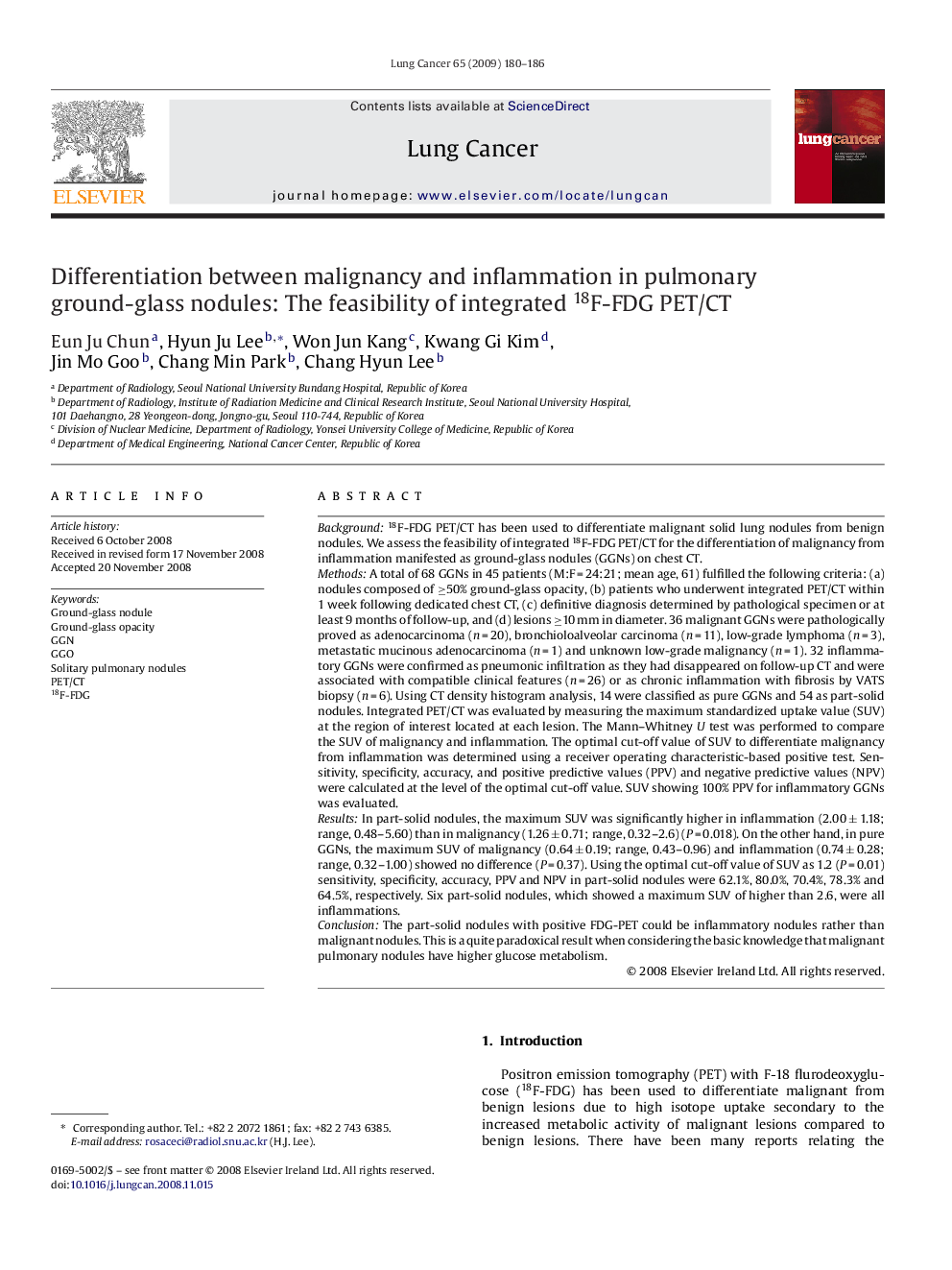| کد مقاله | کد نشریه | سال انتشار | مقاله انگلیسی | نسخه تمام متن |
|---|---|---|---|---|
| 2143186 | 1088338 | 2009 | 7 صفحه PDF | دانلود رایگان |

Background18F-FDG PET/CT has been used to differentiate malignant solid lung nodules from benign nodules. We assess the feasibility of integrated 18F-FDG PET/CT for the differentiation of malignancy from inflammation manifested as ground-glass nodules (GGNs) on chest CT.MethodsA total of 68 GGNs in 45 patients (M:F = 24:21; mean age, 61) fulfilled the following criteria: (a) nodules composed of ≥50% ground-glass opacity, (b) patients who underwent integrated PET/CT within 1 week following dedicated chest CT, (c) definitive diagnosis determined by pathological specimen or at least 9 months of follow-up, and (d) lesions ≥10 mm in diameter. 36 malignant GGNs were pathologically proved as adenocarcinoma (n = 20), bronchioloalveolar carcinoma (n = 11), low-grade lymphoma (n = 3), metastatic mucinous adenocarcinoma (n = 1) and unknown low-grade malignancy (n = 1). 32 inflammatory GGNs were confirmed as pneumonic infiltration as they had disappeared on follow-up CT and were associated with compatible clinical features (n = 26) or as chronic inflammation with fibrosis by VATS biopsy (n = 6). Using CT density histogram analysis, 14 were classified as pure GGNs and 54 as part-solid nodules. Integrated PET/CT was evaluated by measuring the maximum standardized uptake value (SUV) at the region of interest located at each lesion. The Mann–Whitney U test was performed to compare the SUV of malignancy and inflammation. The optimal cut-off value of SUV to differentiate malignancy from inflammation was determined using a receiver operating characteristic-based positive test. Sensitivity, specificity, accuracy, and positive predictive values (PPV) and negative predictive values (NPV) were calculated at the level of the optimal cut-off value. SUV showing 100% PPV for inflammatory GGNs was evaluated.ResultsIn part-solid nodules, the maximum SUV was significantly higher in inflammation (2.00 ± 1.18; range, 0.48–5.60) than in malignancy (1.26 ± 0.71; range, 0.32–2.6) (P = 0.018). On the other hand, in pure GGNs, the maximum SUV of malignancy (0.64 ± 0.19; range, 0.43–0.96) and inflammation (0.74 ± 0.28; range, 0.32–1.00) showed no difference (P = 0.37). Using the optimal cut-off value of SUV as 1.2 (P = 0.01) sensitivity, specificity, accuracy, PPV and NPV in part-solid nodules were 62.1%, 80.0%, 70.4%, 78.3% and 64.5%, respectively. Six part-solid nodules, which showed a maximum SUV of higher than 2.6, were all inflammations.ConclusionThe part-solid nodules with positive FDG-PET could be inflammatory nodules rather than malignant nodules. This is a quite paradoxical result when considering the basic knowledge that malignant pulmonary nodules have higher glucose metabolism.
Journal: Lung Cancer - Volume 65, Issue 2, August 2009, Pages 180–186